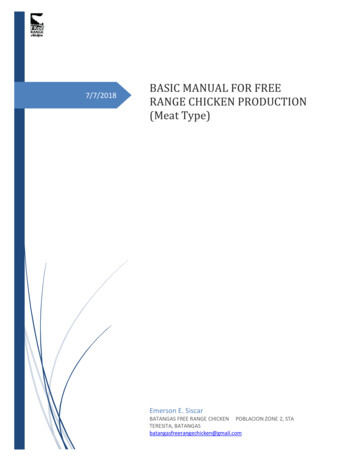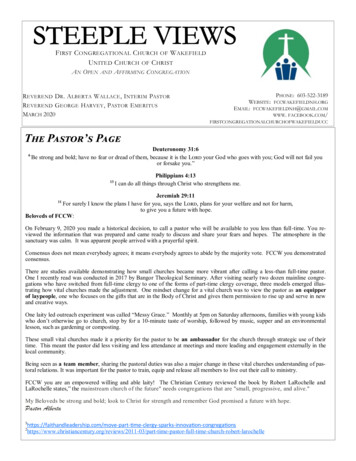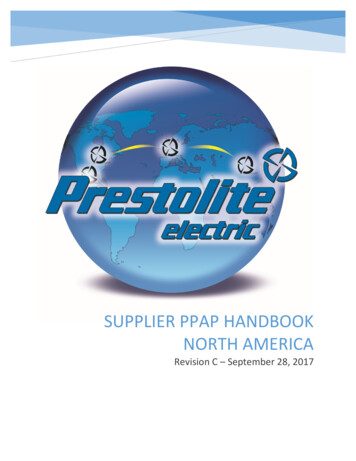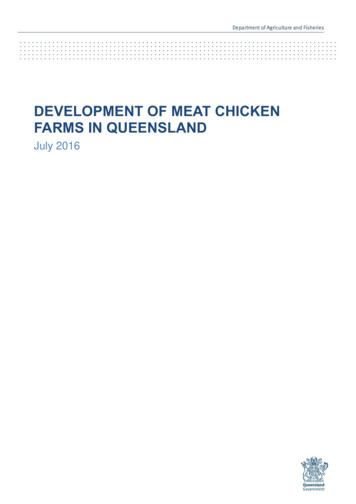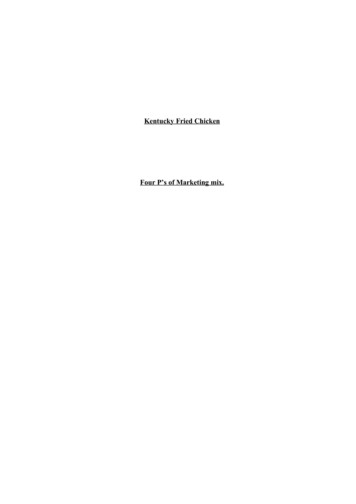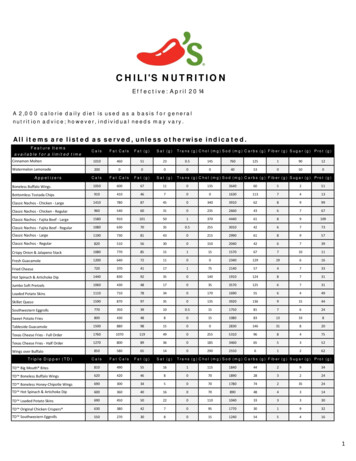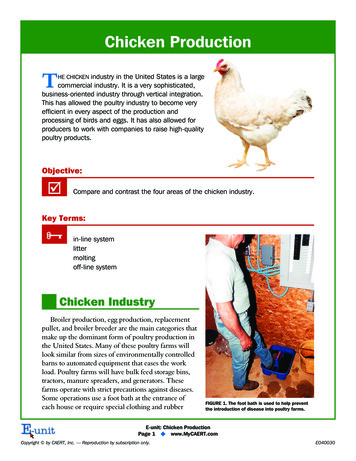
Transcription
Chicken ProductionTHE CHICKEN industry in the United States is a largecommercial industry. It is a very sophisticated,business-oriented industry through vertical integration.This has allowed the poultry industry to become veryefficient in every aspect of the production andprocessing of birds and eggs. It has also allowed forproducers to work with companies to raise high-qualitypoultry products.Objective:þCompare and contrast the four areas of the chicken industry.Key Terms:Ñin-line systemlittermoltingoff-line systemChicken IndustryBroiler production, egg production, replacementpullet, and broiler breeder are the main categories thatmake up the dominant form of poultry production inthe United States. Many of these poultry farms willlook similar from sizes of environmentally controlledbarns to automated equipment that eases the workload. Poultry farms will have bulk feed storage bins,tractors, manure spreaders, and generators. Thesefarms operate with strict precautions against diseases.Some operations use a foot bath at the entrance ofeach house or require special clothing and rubberFIGURE 1. The foot bath is used to help preventthe introduction of disease into poultry farms.E-unit: Chicken ProductionPage 1 u www.MyCAERT.comCopyright by CAERT, Inc. — Reproduction by subscription only.E040030
boots to prevent disease contamination. Other operations do not require any visitors on-site.Vertical integration has allowed for the chicken industry to focus on these areas and design aproduction system that is optimally efficient.BROILER PRODUCTIONProducing meat is the main focus of the broiler production area in the chicken industry.This form of production concentrates on growing meat birds by the fastest and most efficientmethod possible. Producers will enter into a company contract, receive birds from a hatchery,and generate broilers to market weight in about six weeks.Broiler FacilitiesBroilers are typically raised in specialized buildings that are completely opened inside,allowing the chickens to roam the entire area. Broilers are not raised in cages. These buildingsoffer automated heating, ventilation, water, and feed systems. The floor used in a broiler production building is an earthen floor that is covered by “litter.” Litter is an absorbent materialthat serves as bedding.Broiler Production PracticesCleaning after every group is essential to ensure a clean environment for young birds. Disinfecting walls and equipment will prevent disease contamination. Also, removing all old litterand spreading about 2 to 4 inches of clean, dry bedding on the floor helps prevent disease.Waste management is a key production practice that must have a particular plan even beforepoultry buildings are built.Water quality is a very important factor in raising high-quality, healthy birds. Some operations use water treatment plans to guarantee the safest, cleanest water for their growing birds.When young birds arrive, temperatures should be set at 90 to92 F, feed in place, and a recordkeeping system be set. Once thebirds start to grow, temperaturescan be dropped to 65 F for an endtemperature of production. Therecord keeping system will keeptrack of feed consumed and delivered, mortality, vaccination dates,and medications used. Followingfeeding schedules and maintaining all equipment during production should be top priorities forFIGURE 2. Raising broilers in a temperature-controlled environment can helpthe operation.reduce potential health problems.E-unit: Chicken ProductionPage 2 u www.MyCAERT.comCopyright by CAERT, Inc. — Reproduction by subscription only.E040030
Daily care and observation of health are important steps to maintain a mortality rate of nomore than 5 percent. Company representatives also help producers with feeding schedules andvaccination programs. This help from the company assures fewer risks for producers andallows them more time for maintenance of housing and equipment.Factors Affecting Broiler ProductionThe factors that affect profitability in broiler production are bird weights, livability, contractagreements/payments, and cash operating factors like fuel, litter, electricity, maintenance, andrepair. Proper maintenance of buildings and equipment by the producer instead of contractingthese jobs out will help maintain lower costs. Other factors are consumer demand and marketconditions. This will affect bird placement and schedules. The producer wants to have his orher buildings full at all times to provide a proper income. Environmental management practices, like litter distribution, dead bird disposal, air/water quality, and dust/odor management,can cause an increase in cost if the producer does not maintain a proper management system.Selecting Broiler BirdsSelection of broiler chicks should come from a reputable hatchery and express qualitybroiler strains. It is common to only raise pullet chicks; however, cockerels will grow morerapidly. Pullets will carry more flesh over the back and breast than cockerels. This will give thepullets a more rounded appearance to the breast, thighs, and legs.EGG PRODUCTIONEgg production involves the production of high-quality eggs for human use. Laying hensare housed in specifically designed cages in a sound, ideal environment. Typically, the eggs arecollected, cleaned, and graded on-site. Producers maintain clean, well-efficient facilities and tryto get one egg per hen each day.Egg Production FacilitiesEgg production buildings orlayer houses also use automatedheating, ventilation, water, andfeed systems. These birds arehoused in specially designed cagesthat offer comfort and goodhealth to the hens. These cagesprovide a feeder tray and waternipple. Below the cages is anautomated egg collecting system.This system allows eggs to be collected in a very efficient and sanitary manner.FIGURE 3. These chickens are housed specifically for the purpose of layingeggs. (Courtesy, Mississippi State University)E-unit: Chicken ProductionPage 3 u www.MyCAERT.comCopyright by CAERT, Inc. — Reproduction by subscription only.E040030
Egg Production PracticesRaising layers for egg production requires attention to lighting, temperature, feeding, eggproduction, and egg collection. It is very important to provide hens an ideal environment toproduce eggs. Control panels within the building control the lighting program for the hens.Light programs are important because the length of light hours indicates to the birds when tobegin egg production. When hours of light are increased, hens are brought into production.The ideal temperature range for a shell egg layer house is set between 57 and 79 F.Providing full feed to egg-producing hens is a general practice used in egg production operations. An important production practice is to ensure young pullets have reached a proper bodyweight before the onset of laying eggs. Producers should maintain healthy birds through constant, daily observation of birds, feeding amounts, and egg production. Records are essential toegg-producing operations andshould be a top priority. Duringegg production, producers needto keep a watchful eye on thebody condition of the hens. Thiswill help the producer to decidewhen to molt the flock. A common production practice in shellegg layer houses is to inducemolting. Molting is a period oftime when the birds will shed andrenew their feathers.There are two types of egg collection systems used in egg proFIGURE 4. Egg-producing hens are closely monitored to ensure properduction operations. The in-linehealth. (Courtesy, USDA)system allows for laying, collection, and grading to take place at one facility. The off-line system transports the eggs out ofthe laying house directly to an egg cooling room and then transported to an egg processingfacility. Most modern egg production operations use an in-line system. The egg is transportedby a conveyer belt to the egg processing facility. The eggs are washed, inspected, and graded forpackaging. Once packaged, the eggs move to a cooler room at 40 to 45 F and awaits shipment.FURTHER EXPLORATION ONLINE CONNECTION: Cooking with EggsDo you like to cook? Do you like to try new tastes, flavors? Eggs provide a very nutritious and deliciouschoice for cooking. Eggs provide a source of high-quality protein and 13 essential nutrients. Eggs are alsoa great source of riboflavin. Eggs are very popular on a breakfast menu. However, eggs can also be usedin salads, appetizers, snacks, and on several different types of sandwiches. There are many different waysto prepare and enjoy eggs.To find out more about cooking and the nutritional benefits of eggs, visit the link http://www.aeb.orgE-unit: Chicken ProductionPage 4 u www.MyCAERT.comCopyright by CAERT, Inc. — Reproduction by subscription only.E040030
Factors Affecting Egg ProductionThe factors that affect profitability in egg production are contract payments/agreements andcash operating factors like fuel, electricity, maintenance, and repair. Other factors, such as henproductivity, feeding system, vaccination schedules, and molting, will also influence profitability. Companies provide assistance with feeding and vaccination programs. It is important tomaintain an efficient system in an egg-producing operation. Producers must maintain allaspects of the process, as well as provide a clean, healthy environment for the hens.Selecting Egg Production BirdsSelection for egg production should include thefollowing characteristics: soft, enlarged comb andwattles; wide, moist vent; increased distance betweenthe pelvic bones; increased distance between pelvicarch and keel; velvety skin; and soft, pliable, enlargedabdomen. Characteristics of a hen that is out of production would include the following: short, hard,shriveled comb and wattles; small, puckered, and dryvent; little distance between the pelvic bones; shortdistance between pelvic arch and keel; tight, coarseskin; and firm abdomen. There are many moredetailed characteristics for hens in production andshould be fully observed before selection.REPLACEMENT PULLETSFIGURE 5. Many characteristics are observed whenselecting a healthy hen for egg production.Replacement pullets are raised for egg production. These pullets will replace hens in current egg production. The pullets are raised until they reach 20 weeks of age by the pullet producer. These birds are then transferred to an egg production site.Replacement Pullet FacilitiesReplacement pullets are raised in a building that is like a broiler house. The birds are grownin a similar environment and use similar equipment for feed and water. Once these birds areready to come into production, they are moved to a layer house.Replacement Pullet Production PracticesCommon production practices include maintenance of facilities, feeding, and daily care ofyoung, growing pullets. Pullet producers grow specially bred chicks for egg laying production.These chicks are hatched at a hatchery and are moved to a pullet production operation within aday or two of being born. The chicks have been vaccinated before arriving at the operation.Companies are very specific about vaccination programs and are generally overseen by comE-unit: Chicken ProductionPage 5 u www.MyCAERT.comCopyright by CAERT, Inc. — Reproduction by subscription only.E040030
pany representatives. The producer should be ready for these young chicks with a clean,healthy facility. Feed and high-quality water should be ready and available.The pullet production, sometimes referred to as the pullet replacement, operation willmaintain these birds until they are 20 weeks of age. Once the pullet has reached this age, it willbe transferred to a laying farm for egg production. Pullets typically are mature enough for egglaying at 24 weeks.Maintenance of facilities issimilar to the practices of a broileroperation. Cleaning, disinfecting,and providing a safe, healthy environment for the birds is a top priority. Temperatures are uniformly. Providing properventilation is a good productionpractice that will also help regulate appropriate temperature andremove excess moisture. Wastemanagement is also a top production practice and should be set upbefore the birds arrive.FIGURE 6. The tires of vehicles that enter this farm are sanitized to ensure ahealthy environment.Following feeding schedulesduring production should be a toppriority for the operation. There will be more time required during the early stages of growth.Daily care and observation of health are important steps to maintain a healthy and productiveflock.Factors Affecting Pullet ProductionThe most important factor in pullet production is producing a uniform flock with properweights. The uniform flock will be more efficient, have a higher peak production, and willexpress their full genetic potential. It is the responsibility of the grower to ensure a uniformflock under ideal environmental settings, feeding, and care. Many companies will provide payment/contract incentives for uniformity and ideal body weight.ENTHELPAWDON THE JOB CAREER CONNECTION: Poultry CareersEver wonder what a career in the poultry industry would include? There are so many differentand exciting opportunities that are offered within the industry. A processing manager, a nutritionist, an engineer, a marketing specialist, or a geneticist all have a spot within the industry and allprovide rewarding careers. Poultry science as a major in college with an emphasis on particularareas, such as marketing or nutrition, will allow a young person to enter into the poultry field. Formore information on poultry careers, visit the link http://www.poultrycareers.orgE-unit: Chicken ProductionPage 6 u www.MyCAERT.comCopyright by CAERT, Inc. — Reproduction by subscription only.E040030
Selecting Pullets for ReplacementPullet replacement chicks should come from a reputable hatchery and express quality egglaying genetics and traits. As pullets grow, the producer should have sufficient knowledge inorder to identify poor growth in birds. A good layer must have ideal body condition and attainthe proper body weight to support egg production.BROILER BREEDERSBroiler breeders are chickens that are used to produce fertile eggs that will be hatched tobecome broilers. These chickens are selected based on genetic background and their potentialto produce high-quality meat birds.Breeder FacilitiesBroiler breeder facilities need toprovide an area for growing,breeding, and nest boxes. Somebroiler breeder houses have twolevels. The breeding, feeding areais similar to that of the broiler production house. The flooring iscovered with litter, and the birdscan roam the space. The upperlevel is designed for the nest boxes.This is where the hens lay eggs.These eggs are transported on aconveyor belt to the egg collectionroom. The eggs are boxed up andsent to a hatchery. Automatedfeeders and waterers are used.FIGURE 7. Litter used on flooring is usually made of wood shavings.Breeder Production PracticesThere are specific production practices that must occur for high-quality birds to be bredand raised. Breeding bird production includes the daily care and feeding of the females andmales, which are raised in separate buildings. These operations are contracted out by poultrycompanies to raise breeder chicks to adult birds.The female and male birds are kept separately and raised similar to a broiler operation. Thebuildings provide a wide-open space for birds to roam. Automated feeders and waterers areused. Lighting in these houses is very important, because the number of light hours affect eggproduction. It is crucial to raise hens to a specific weight before production can begin. Oncethe female birds are 20 to 25 weeks old, they are moved into the breeder house. The femaleswill move onto the nest boxes to lay fertile eggs. Once the egg is laid, it will be transported toan egg collection room by a conveyor belt. These eggs are boxed and sent to a hatchery.E-unit: Chicken ProductionPage 7 u www.MyCAERT.comCopyright by CAERT, Inc. — Reproduction by subscription only.E040030
It is very important to maintain a stress-free environment for these birds. Reproductionwould suffer if anything interrupts their environment. Areas that are free of noise are animportant factor to maintain a low stress environment, especially in the nesting area. Preciselycontrolled temperature and lighting systems are very important to maintain efficient production and reproduction in a breeder house.Company representatives assist with the designed feeding program. Males and females arecarefully controlled through feed intake levels, body weight, and condition. Producing pulletsthat are ideal in weight and condition will meet the goal of high egg production. Attention tothe health of both males and females will ensure adequate fertility and production. Carefullycontrolled operations, along with well-detailed recordkeeping, will provide the producer ahighly efficient return.The producer must provide strict sanitation procedures for effective disease control. Cleaning and disinfecting the house and equipment are proper production practices. Maintainingadequate ventilation and clean, dry bedding will also result in cleaner hatching eggs. Temperatures in a breeder house typically range from 65 to 75 F.Factors Affecting BroilerBreeder ProductionFactors affecting profitabilityin breeding bird production arecontract payments/agreementsand cash operating factors likefuel, electricity, maintenance, andrepair. Other factors, such asenvironmental settings, feedingsystem, vaccination schedules,and care, will also influence profitability.FIGURE 8. For efficient growth, ample lighting is necessary in poultryhousing.Selecting Broiler Breeder BirdsBreeding birds are carefully selected and owned by companies. These birds will expresshigh-quality meat and rate of growth. Some common assessments used to identify growthpotential are skull width, heart girth, back flatness/length/breadth, body depth/capacity, breastand keel, weight, and color. A wide skull is an indicator of growth potential. A good heart girthand body depth/capacity will indicate enough space for internal organs that will maximizegrowth and development. Flat backs are a sign of good bone development. The examination ofthe breast and keel will determine good meat proportions.Summary:2Broiler production, egg production, replacement pullet, and broiler breeder are themain categories that make up the dominant form of poultry production in theUnited States. Many of these poultry farms will look similar from sizes of environE-unit: Chicken ProductionPage 8 u www.MyCAERT.comCopyright by CAERT, Inc. — Reproduction by subscription only.E040030
mentally controlled barns to automated equipment that eases the work load. Poultryfarms will have bulk feed storage bins, tractors, manure spreaders, and generators.These farms operate with strict precautions against diseases. Some operations use afoot bath at the entrance of each house or require special clothing and rubber bootsto prevent disease contamination. Other operations do not require any visitorson-site. Vertical integration has allowed for the chicken industry to focus on theseareas and design a production system that is optimally efficient.In the modern poultry industry, companies supply the birds to the producers. Producers rarely, if ever, get a say in the type or source for the birds in production.Contract agreements are made between the company and the producer. Contractsusually state who will provide the birds, feed, medication, utilities, and labor. Identifying high-quality, superior birds is an essential step in each of the production systems. A good poultry producer will exhibit this knowledge and provide sound managerial skills and understanding of producing and preserving the quality of birdsdelivered.Checking Your Knowledge: 1. What are the similarities and differences of broiler and replacement pullet production?2. What is some common equipment used on all types of poultry operations?3. In a contract agreement with a company, what are the common factors thataffect profitability?4. How can light affect the production of eggs?5. What is the difference between an in-line system and an off-line system in eggproduction?6. What are the key factors when selecting superior animals for each area inchicken production?Expanding Your Knowledge:LResearch the responsibilities of a fertile egg producer. What is the producers role indeveloping new strains or lines of breeds to improve egg production? How canDNA be used in the breeding and developing of birds within the chicken industry?Web Links::National Chicken Councilhttp://www.nationalchickencouncil.comU.S Poultry & Egg Associationhttp://www.poultryegg.org/E-unit: Chicken ProductionPage 9 u www.MyCAERT.comCopyright by CAERT, Inc. — Reproduction by subscription only.E040030
allowing the chickens to roam the entire area. Broilers are not raised in cages. These buildings offer automated heating, ventilation, water, and feed systems. The floor used in a broiler pro-duction building is an earthen floor that is covered by “litter.” Litter is an absorbent mate




